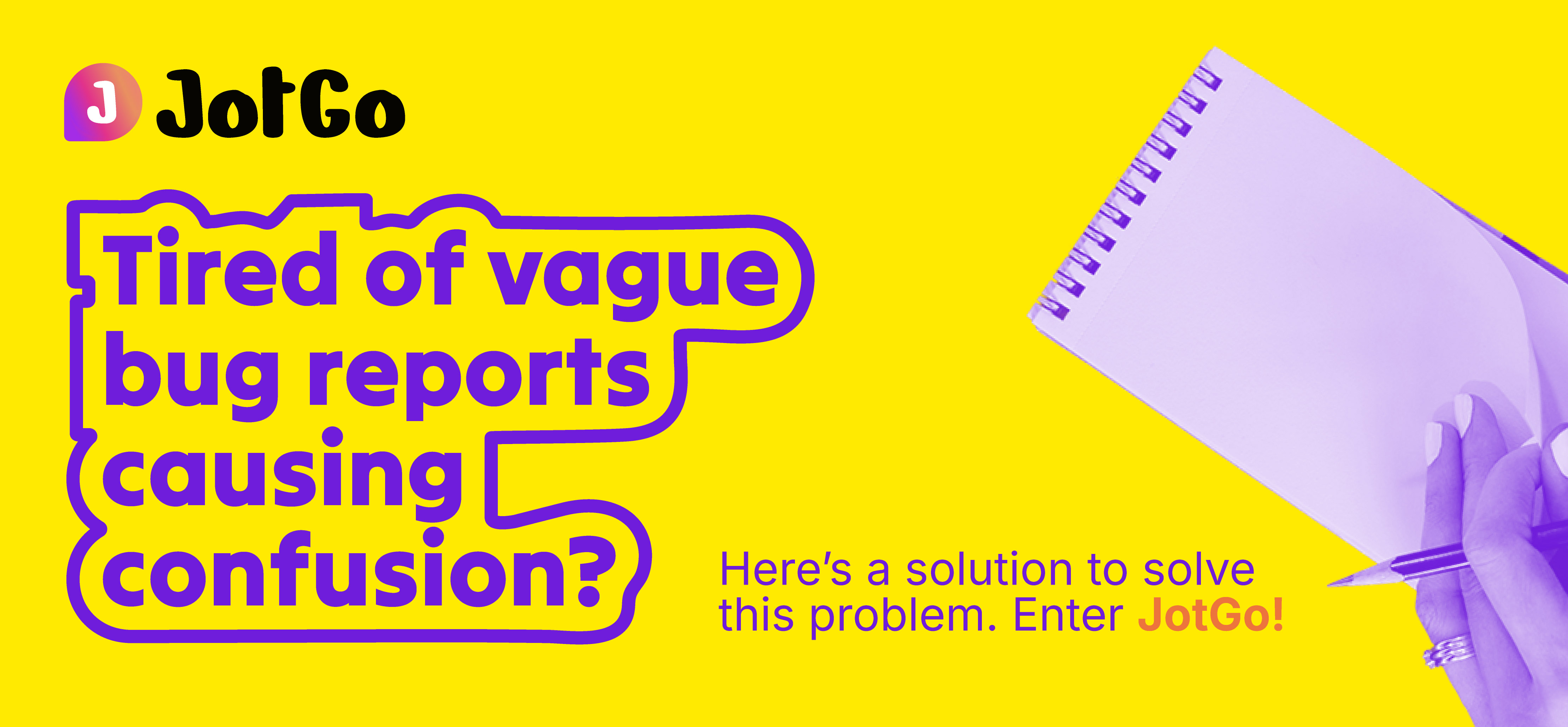Dealing with Vague Bug Reports? A Framework for Precision

Bug reports are the lifeline of any development team. They connect users and testers to developers, guiding the resolution of issues that disrupt product performance. But vague bug reports - those that lack detail, context, or actionable insights—often lead to confusion, wasted time, and miscommunication among teams. If you've ever felt frustrated deciphering a report that simply says, "The app crashes when I click something", you're not alone.
The good news? Writing a precise bug report is not rocket science. With the right framework, you can ensure every report is clear, actionable, and effective. And when paired with a tool like JotGo, these steps become second nature.
Here’s a guide on creating bug reports that your developers will actually love.
Why Clear Bug Reports Matter
Imagine you’re a developer and you receive a bug report saying, “The website is broken.” What do you—justifiably—ask first? What’s broken? What browser were the testers using? Which page were they on?
A precise bug report eliminates ambiguity and answers critical questions before they’re asked. Here are the main benefits of clear bug reports:
- Saves Time: Developers can jump straight into the issue without wasting hours back and forth gathering additional details.
- Prevents Misunderstandings: With the right information, there’s no misinterpreting what the bug entails.
- Improves Turnaround Time: The development team resolves issues faster when they don’t have to dig for clues.
- Strengthens Collaboration: Teams feel empowered when communication is streamlined and efficient.
Precision in bug reports isn’t just a nice-to-have—it’s essential for smooth project execution.
The Framework for Precise Bug Reports
Writing a clear bug report starts with understanding what information developers need. Here’s a simple framework to follow:
1. Descriptive Title
A bug report’s title should clearly summarize the issue. Think of it as the headline for the problem. Replace vague titles like "Error in app" with something actionable like "App crashes when tapping 'Save' on the Profile screen."
2. Environment Details
Context is everything. Make sure to include:
- Device/Platform (e.g., iPhone 13, Windows 11)
- Operating System and Version (e.g., iOS 17.0.2)
- Browser (if applicable, e.g., Google Chrome v118)
- App Version or Build Number
This ensures the team knows exactly where to replicate the problem.
3. Steps to Reproduce
Explain the issue as if you’re walking someone through it for the first time. Use numbered steps, like so:
- Open the app and log in.
- Navigate to the "Profile" tab.
- Tap "Save Preferences."
- Observe a crash to the home screen.
These steps should be concise and easy to follow.
4. Expected vs. Actual Behavior
Clarity lives in comparison. What did you expect to happen? And what actually happened?
- Expected Behavior: The app saves the user's preferences and shows a success message.
- Actual Behavior: The app crashes to the home screen immediately.
5. Visual Proof
If a picture is worth a thousand words, a screenshot or video can be worth a hundred bug-free deployments. Attach screengrabs or recordings to make your report more impactful. Highlight anomalies with annotations when necessary.
6. Additional Notes
Include anything else that could influence the issue, such as:
- Was the bug intermittent or consistent?
- Were there any specific network conditions (e.g., slow/no connection)?
- Has this issue occurred in previous builds?
The better the context, the more actionable your bug report becomes.
Streamline Bug Reporting with JotGo
Following the framework above can solve many of the frustrations caused by vague bug reporting. But it requires effort—and in fast-paced environments, effort isn’t always possible. That’s where JotGo steps in.
JotGo simplifies the art (and science) of bug reporting with an intuitive interface that ensures every report includes all the essential details, automatically.
How JotGo Makes it Easy
- Auto-Capture Context: JotGo automatically records environment details like platform, browser, and operating system whenever a bug is flagged.
- Pre-Formatted Steps: Reporters can effortlessly log reproduction steps using JotGo’s structured template.
- Built-In Media Upload: Directly upload screenshots or video clips to highlight the issue, reducing communication gaps.
- Customizable Fields: Add project-specific information to tailor reports for your developers.
- Seamless Integration: Sync JotGo with your favorite project management tools (like Jira, Trello, or Slack), creating a frictionless workflow.
When you pair the precision framework with JotGo, the reporting process becomes not just seamless but enjoyable, too.
Clear Bug Reports Prevent Misunderstandings
To showcase the difference a precise bug report can make, consider these two examples reporting the same issue:
Example 1: Vague Report
"The app crashed while I was using it."
What’s missing? Pretty much everything. The team doesn’t know what caused the issue, how to reproduce it, or even where to begin diagnosing it.
Example 2: Clear Report
Title: App crashes when uploading images larger than 5MB
Environment: iPhone 12 Pro, iOS 16.1, App Version 3.1.0
Steps to Reproduce:
- Open the app and log in.
- Go to the "Upload" screen.
- Select a photo larger than 5MB.
- Tap "Submit."
Expected Behavior: The image uploads successfully.
Actual Behavior: The app crashes to the home screen.
Attachments: Video showing the app crash (attached).
This clear report allows the development team to locate and fix the bug quickly with minimal back-and-forth.
Build a Better Workflow with Precise Reporting
Clear bug reports are an investment in your team’s success. By following a structured framework—or using a solution like JotGo—you reduce wasted time, frustration, and communication overhead. Every precise report you file ensures smoother collaboration and faster resolutions.
If you’re ready to eliminate the hassle of bug reporting, give JotGo a try. Streamline your process, improve team dynamics, and get back to what you do best—building awesome products.
Sign up for JotGo today and experience the future of bug reporting.











